![]()
![]()
![]()
Use LEFT and RIGHT arrow keys to navigate between flashcards;
Use UP and DOWN arrow keys to flip the card;
H to show hint;
A reads text to speech;
24 Cards in this Set
- Front
- Back
|
What is Homeostasis? |
“is the condition of equilibrium in the body’s internal environment produced by the ceaseless interplay of all the body’s regulatory processes” (Tortora and Grabowski, 1999,page 6) |
|
|
What is a stressor? |
Any factor (inside or outside the body) that acts on the body and disturbs the body is known as a stressor There are 2 types: -Internal stressor- for example, a virus, internal haemorrhage. External stressor- for example, environmental temperature |
|
|
Internal environment |
The internal environment is the environment that surrounds the cells Interstitial fluid (sometimes called tissue fluid): - fluid that leaves the blood capillaries to “bathe” the cells bringing O2 and nutrients and returns to the blood carrying cellular waste products e.g CO2 and ammonia Intercellular fluid: - fluid in the narrow spaces between cells Blood plasma: -The fluid part of the blood that surrounds blood cells |
|
|
Cellular environment |
The chemicals within the cell must be maintained within narrow limits otherwise they may become subjected to altered activity There are at least 10,000 different enzymes that behave optimally only if pH, temperature and concentration are kept reasonably constant |
|
|
Feedback terminology |
Feedback system-cycle of events in which status of the body condition is continually monitored evaluated changed Any disruption that changes a controlled condition is called a stimulus |
|
|
Loop neither positive or negative |
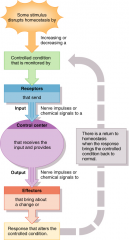
|
|
|
Receptor |
A structure that monitors changes in a controlled condition. Sends an input(nerve/chemical) to the control centre. Baroreceptors -pressure receptors Chemoreceptors-monitor pH, Oxygen and other chemical levels Proprioreceptors-monitor physical activity. Thermoreceptors-monitor temperature changes. |
|
|
Dermatomes |
The skin over the entire body is suppliedby spinal nerves that carry somatic sensorynerves impulses into the spinal cord and brain stem.All spinal nerves, except C1 innervate specific,constant segments of the skin; the skinsegments are called dermatomesKnowledge of these help doctors todetermine which segment of the spinal cord orwhich spinal nerve is malfunctioning.Skin on the face supplied by the 5th Cranial Nerve |
|
|
Dermatomes |
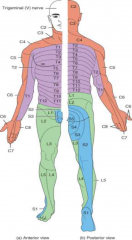
There is overlap between segments. Spinal cord injury can be determined partly by response to stimulus to dermatomes |
|
|
Control centre |
Sets the range of values within which the controlled condition should be maintained. Cardiovascular centre in the medulla oblongata.Higher brain centre-cerebral cortex,limbic system,hypothalamus. |
|
|
Effector |
A body structure that receives inputs (nerve /chemical signal) from the control centre and produces a response or effect that changes the controlled condition Heart Skin Sweat glands |
|
|
Positive feedback cycle |
Tends to strengthen or reinforce a change in the condition. Has to include a termination mechanism to bring the process to a halt. labour ovulation |
|
|
Positive feedback loop |
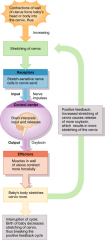
|
|
|
Positive feedback loop example |
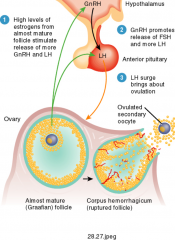
|
|
|
Negative feedback cycles |
Reverses a change in a controlled condition.Tend to regulate conditions in the body that are held fairly stable over long periods of time. Temperature regulation Heart rate and blood pressure, Blood glucose level, hormone levels. |
|
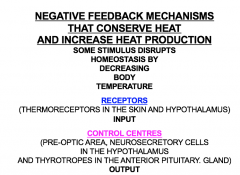
|

|
|
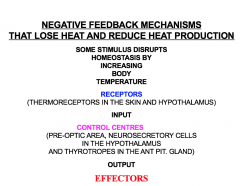
|
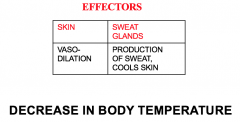
|
|
|
Heart rate and blood pressure |
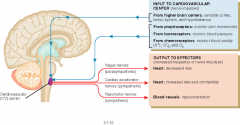
|
|
|
Heart rate and blood pressure |
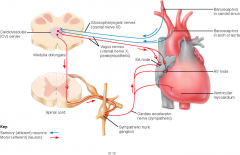
|
|

|
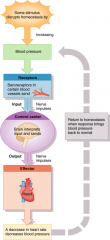
|
|
|
Intrinsic factors |
Increase venous return to the heart by muscle contractions in limbs cardiac output=stroke volume X heart rate Peripheral resistance-relaxation of smooth muscles makes them wider-less resistance-lower BP. |
|
|
Other variations |
Age- new born babies heart rate 120bts/min Adult females have slightly higher resting heart rates than men Increase in body temperature eg fever or exercise increases heart rate Decrease in body temperature decreases heart rate useful in heart operations |
|
|
Clinical interest |
Beta-blockers block the sympathetic system Also output to adrenal medulla via sympathetic-leads to production of epinephrine and norepinephrine mimics sympathetic symptoms-faster and stronger contractions-cardiac output increased |
|
|
Clinical interest |
Thyroid hormones -Enhance cardiac contractility-hence hyperthyroidism leads to tachycardia Levels of Na+ ,K+ decrease contractility and heart rate Ca2+ strengthens and speeds heart rate |

